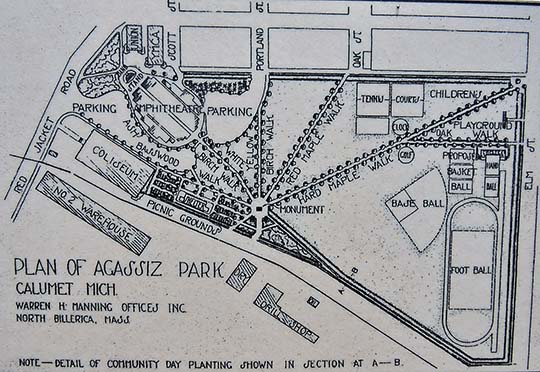Agassiz Park clean-up first step in process

Graham Jaehnig/Daily Mining Gazette The original plan of Agassiz Park, as drawn by designer Warren Manning in 1920, show that over the years, much of the park has been taken up by village expansion.
CALUMET — A project to improve the village’s once iconic Agassiz Park started Wednesday morning, when resident volunteers were joined by approximately 300 students from Calumet High School to begin clean-up efforts of the park, along with the Theatre Park on Sixth Street.
Executive Director of Main Street Calumet and the Downtown Development Authority Leah Polzien spent the morning with two students, raking the Theatre Park, removing trash and dead tree branches. The Theatre Park has been home to the area Farmer’s Market for approximately three years.
“This is really hard work,” said Polzien, “and these kids are doing a phenomenal job. They are incredible workers.”
At Agassiz Park, Village President Dave Geisler said that it is great to see people taking care of their town, adding that has been a real community event.
“Wouldn’t it be great to see the park returned to the way Warren Manning designed in 1920?” he said.
The original plans for the park included space for a band shell, and a baseball diamond. It also had tennis courts, and the north end of the park was bordered by the football field, which is used today by the Calumet Kings for both football and track.
When asked if there were plans to return the statue of Alexander Agassiz to the park, where it was originally located, Geisler said he is not sure who owns it.
Agassiz Park was purchased by the village, he said. It was originally on Calumet and Hecla Mining Company property, and before the park was created in 1922-23, it was, in following with Boston, Massachusetts, culture, referred to simply as “the common,” where company employees could pasture their milk cows.
“From what I’m told,” said Geisler, “When Lake Superior Land Company owned the property, they were the ones who had the Agassiz statue moved to Red Jacket Road. It sits on National Park property, so I’m not sure exactly owns the statue.”
Geisler said there is really no sense in moving it back unless the park is restored, because all the paths in the park led to the statue.
Manning’s plan included four tree-lined paths arranged like the spokes of a wheel, the hub of which was the bronze statue of Agassiz, who was the C&H Mining Company president from 1871 to 1910, when he died. Off the end of Portland Street was parking and an amphitheater, which was intended to include a bandshell.
Village expansion over the years has greatly reduced the original size of the park. The amphitheater was eliminated with the construction of an apartment and housing unit, the tennis courts and most of the children’s playground are now under part of Fourth Street and a parking lot, and of the four walking paths, only the Red Maple Walk remains.


